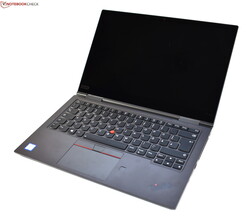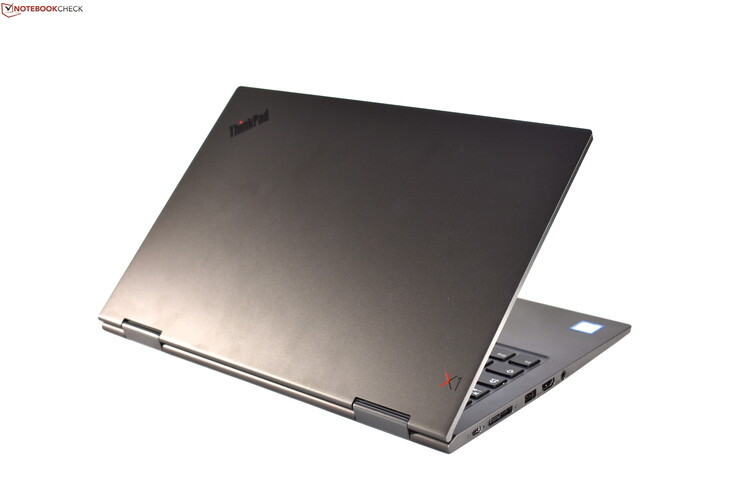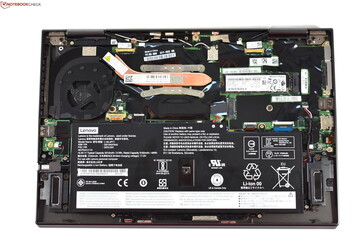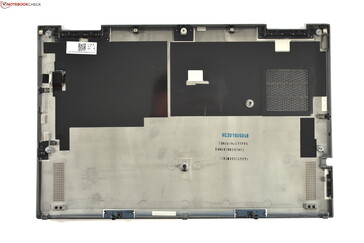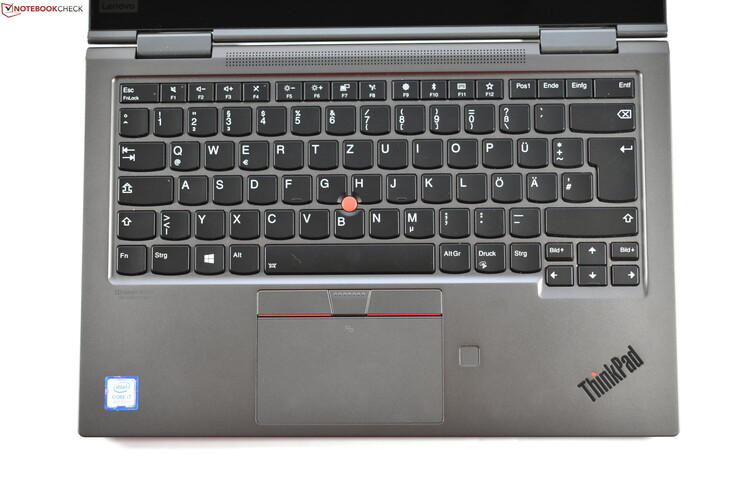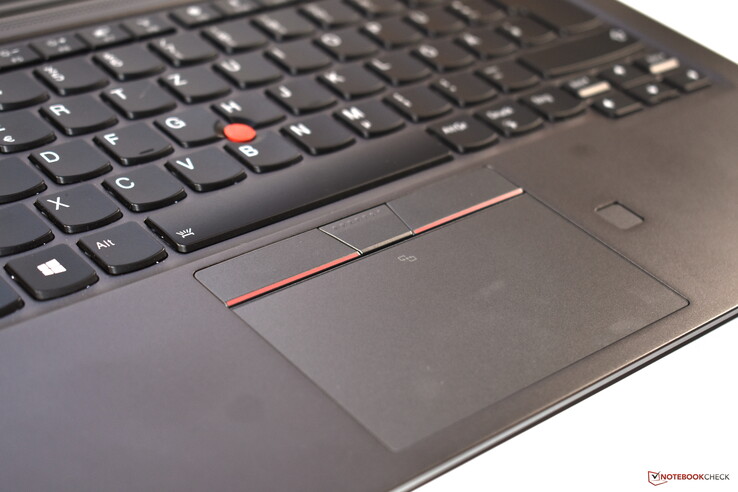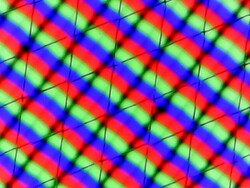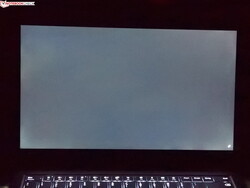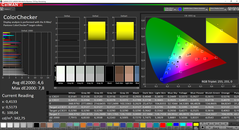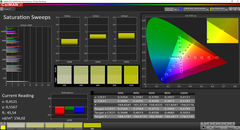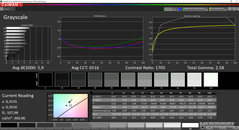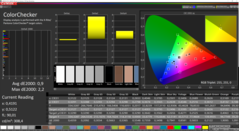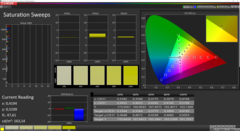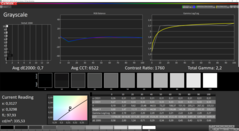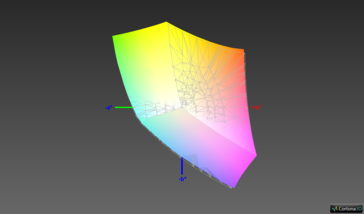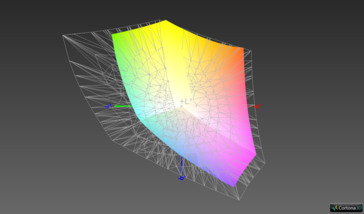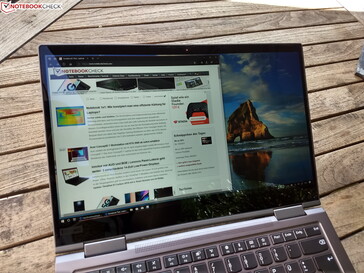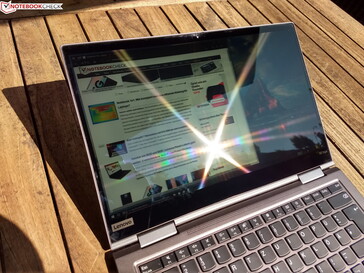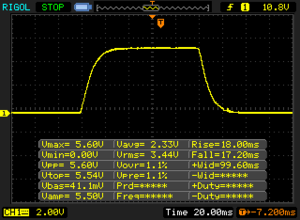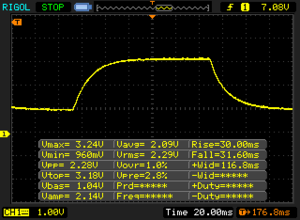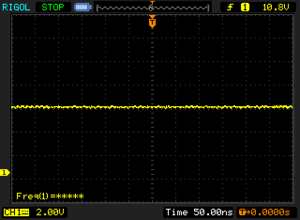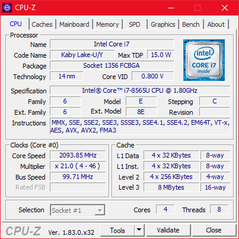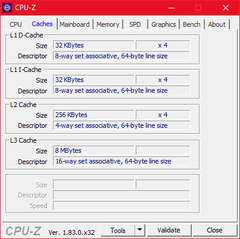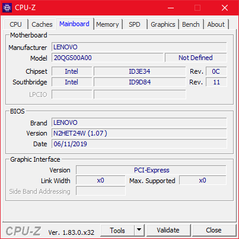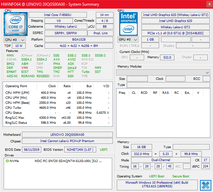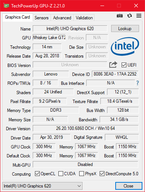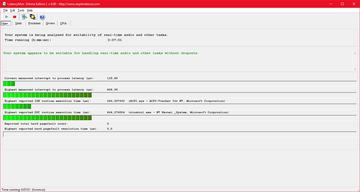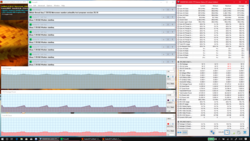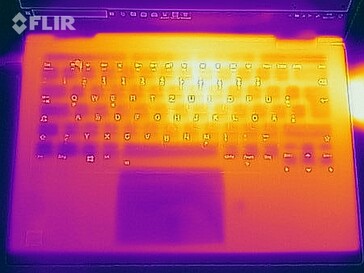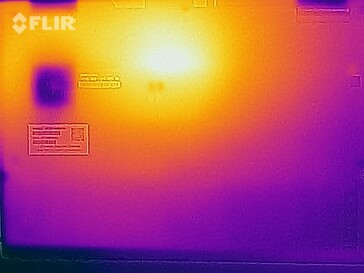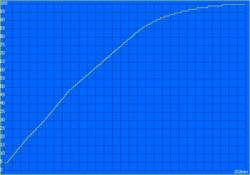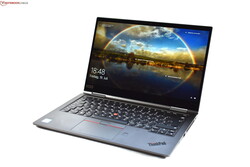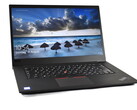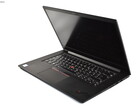Lenovo ThinkPad X1 Yoga 2019 Laptop Review: Aluminum Unibody & Great Speakers
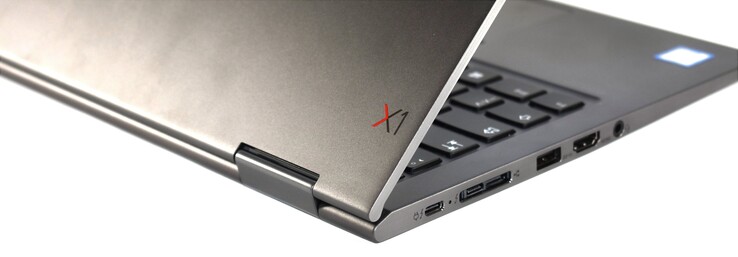
New Lenovo ThinkPads are rarely revolutionary. The manufacturer Lenovo relies more on the evolution of its business series rather than on a constant revolution. One and the same design is mostly used for several years; an example of this is the ThinkPad X1 Yoga series. Since its inception, Lenovo has used the same design, with a few minor changes. Even when it comes to a redesign, hardly anything changes, at least externally, which could be observed, for example, in last year's ThinkPad T480s. With so much consistency, the new ThinkPad X1 Yoga Gen 4 is a small revolution. It is not just a redesign, the ThinkPad X1 Yoga 2019 looks a lot different than its predecessor ThinkPad X1 Yoga 2018. With our review of the Lenovo ThinkPad X1 Yoga 2019 we want to figure out exactly what changes Lenovo has made and also whether they are positive.
In addition to the predecessor model ThinkPad X1 Carbon 2018, the ThinkPad X1 Carbon 2019 in particular serves as a comparison reference. Furthermore , we compare the Lenovo ThinkPad X1 Yoga Gen 4 with its main competitors in the convertible segment of business laptops. These include the Dell Latitude 7400 2-in-1 and the HP EliteBook x360 1040 G5, which, like the Lenovo ThinkPad X1 Yoga 2019, are in the absolute premium class.
This is also evident given the price of the X1 Yoga Gen 4, because the ThinkPad laptop costs in our configuration with i7 CPU, 512 GB SSD, low-power Full HD display, 16 GB of RAM and three years warranty with local service & premier support 1650 Euros (~$1866). This is a special configuration for students and other eligible users of the Lenovo Campus program with no preinstalled Windows. Regularly, the Lenovo ThinkPad X1 Yoga Gen 4 with such equipment and Windows 10 Home costs at least 2300 Euros (~$2600).
Case
Among all the ThinkPad models of the current generation, the Lenovo ThinkPad X1 Yoga Gen 4 stands out in terms of design. The reason for this is the case color, because the body of the X1 Yoga 2019 is - except for the black glass display frame - completely dark gray. It is not the first ThinkPad where Lenovo is using a lighter shade of anthracite-like color tone, but it is the only model of the current generation. About five years ago, all ThinkPads were dark gray, and Lenovo reversed this change from 2016 onwards.
Unlike then, the other color tone is associated with new case materials, which also represents the biggest difference to the previous model ThinkPad X1 Yoga 2018 and the ThinkPad X1 Carbon 2019. Instead of using the well-known combination of magnesium and carbon-fiber plastic, Lenovo is focusing on aluminum in the new ThinkPad X1 Yoga Gen 4. Both the display lid and the palm rest are made of CNC-cut, dark gray anodized aluminum, which also has a polished look on the edges of the case. The display frame is made of glass, while the bottom of the base unit is made of gray-painted magnesium. In this area, Lenovo probably uses the light metal to reduce weight.
Many ThinkPad laptops are already at a very high level in terms of quality, but the ThinkPad X1 Yoga Gen 4 puts something on top of this, at least it feels like it. The case craftsmanship is perfect, the metal feels extremely high quality (and does not get as dirty as the other ThinkPads) and the stability is higher than, for example, the ThinkPad X1 Carbon Gen 7. This is mainly due to the construction of the aluminum case. Of course, aluminum has its weaknesses. Some aluminum laptops experience dents in certain parts of the case, which is not a problem with a carbon fiber case. According to Lenovo, the case has been optimized for the ThinkPad-typical ruggedness; of course we cannot check this without a long-term test. The case is undoubtedly stable: The palm rest does not show any flex and even the display cover, which is often a stability weak point, can hardly be bent.
Since the Lenovo ThinkPad X1 Yoga 2019 is a convertible, one can flip the hinges 360 degrees and use the ThinkPad as a tablet. The hinges make the display shake a little more when jarred than, for example, the ThinkPad X1 Carbon 2019. Moreover, the display cover cannot be opened with one finger. Hinges have always been connected to the keyboard on previous ThinkPad X1 Yoga series models. For example, when the display of the ThinkPad X1 Yoga 2018 was flipped back more than 180 degrees, the keys on the keyboard were mechanically retracted into the base unit. This feature was called the "Wave" keyboard and it should make the use of the device as a tablet easier. Unfortunately, Lenovo has decided not to offer this feature on the new X1 Yoga Gen 4 anymore. In tablet mode, therefore, the keys of the disabled keyboard are often pressed.
A focus of the redesign of the ThinkPad X1 Yoga was the downsizing of the case. For years, the ThinkPad X1 Yoga was larger than the ThinkPad X1 Carbon. With the latest generation, both are almost exactly the same size. Lenovo has also worked on the case thickness, the X1 Yoga is still 0.6 mm (~0.06 in) thicker though. Only by weight is the ThinkPad X1 Carbon 2019 with 1.1 kg (~2.4 lb) significantly better than the ThinkPad X1 Yoga 2019 (1.3 kg/~2.86 lb). Compared to its predecessor, the X1 Yoga 2018, the new ThinkPad X1 Yoga is slimmer and lighter, but above all, more compact. As a result, the display frame has also shrunk significantly, bringing the X1 Yoga to a screen-to-body ratio of 76.7%. Below the LCD, however, the display frame is still slightly wider. Perhaps Lenovo should consider whether switching to a different display format such as 16:10 or 3:2 would make more sense.
Compared to the HP EliteBook x360 1040 G5 and the Dell Latitude 7400 2-in-1, the ThinkPad X1 Yoga Gen 4 is slightly larger, especially the Latitude is much more compact. However, the Lenovo ThinkPad is lighter than the two competitors.
Equipment - No microSD Reader in Lenovo's Convertible Anymore
With the redesign the connection equipment have also changed, there are no fundamental alterations though. The ThinkPad X1 Carbon Gen 4 also features two USB-A ports and a full-size HDMI port. Lenovo does not dare to move to a pure USB-C ThinkPad, which is probably appropriate in the business sector. New on the ThinkPad X1 Yoga 2019 is the mechanical docking connector on the left, which also incorporates the previously stand-alone mini-Ethernet port. This makes the ThinkPad X1 Yoga Gen 4 the first model in this series to be compatible with the same mechanical docks as the more affordable models in the T / X / L series. The only thing that is eliminated compared to its predecessor is the microSD card reader. Lenovo crosses it out without providing an alternative.
The positioning of the connections has changed a lot. This is mainly because Lenovo relocates the fan exhaust port from the back to the right side. As a result, most ports are now left-focused. Fortunately, one of the two USB-A ports remains on the right, so you have a port of this type on both sides. Disadvantage of the new arrangement: As a right-handed mouse user you have to expect getting your hand warm due to the fan exhaust.
Communication
The main communication module is the Intel Wireless AC 9560, a 2x2 Wi-Fi card with Bluetooth 5.0. In everyday life, this WiFi module showed a solid but not flawless performance. The maximum transfer rates in the benchmarks are good, but the signal stability was not quite perfect. Aside from Wi-Fi, the ThinkPad X1 Yoga Gen 4 also comes standard with an integrated Gigabit Ethernet module that can be used via the proprietary mini Ethernet port. A corresponding adapter is enclosed with our test device. Furthermore, this configuration of the ThinkPad X1 Yoga 2019 also has NFC. WWAN or LTE, however, is not available and can not be retrofitted as an option. If you want mobile Internet, then you have to buy a version of the X1 Yoga 2019, which already comes with LTE ex factory. Only these models have the necessary WWAN antennas and the SIM slot on the back.
The camera of the Lenovo ThinkPad X1 Yoga 2019 provides a low-resolution and overall poor quality image. The four microphones in the display lid, on the other hand, record voices very clearly. Overall, the ThinkPad X1 Yoga 2019 is well suited for video telephony.
Security
ThinkPads have many security features as business laptops. For example, the ThinkPad X1 Yoga Gen 4 features a touch-fingerprint reader, a Kensington lock slot, and an infrared camera for Windows Hello. However, a smart card slot is not available. If you want a convertible ThinkPad with a smart card slot, then you have to resort to the less expensive Lenovo ThinkPad X390 Yoga.
Accessories
For a ThinkPad laptop, the ThinkPad Yoga X1 2019 has uncommonly many included accessories. First, of course, would be the mandatory 65-watt power supply with USB-C. The ThinkPad X1 Yoga also has a built-in digitizer stylus, which is integrated in the case on the right side. Finally, included in the delivery is the "ThinkPad Ethernet Extension Cable Gen 2", with which you can use the integrated mini-Ethernet port.
Docking stations are especially interesting as optional accessories. Unlike the older X1 Yoga models, the new ThinkPad X1 Yoga 2019 has a mechanical docking connector, making it compatible with mechanical ThinkPad docks such as the ThinkPad Ultra Dock (40AJ0135EU). This is certainly a very useful feature for large companies that use a whole fleet of different ThinkPads. Of course, you can also use any normal USB-C or Thunderbolt 3 dock.
Maintenance
The ThinkPad X1 Yoga Gen 4 is very easy to open. There are only five screws to unscrew which then remain in position; thus danger of loss does not exist. There are clips, but they do not require any effort, so the bottom panel can easily be removed.
Inside, there is not much to do. The M.2-2280 SSD can be removed and replaced with a more capacious model, but that is all about upgradability. The RAM and the Wi-Fi module are soldered and WWAN is not upgradeable; instead it is either available ex factory or not at all. After all, you can easily clean the cooling system and remove the internal battery without much effort.
As always with the ThinkPads, Lenovo also provides a hardware maintenance manual for the ThinkPad X1 Yoga Gen 4. Interestingly enough, the X1 Yoga 2019 and the X1 Carbon 2019 share the same motherboard design. One can call the X1 Yoga Gen 4 the convertible version of the current X1 Carbon.
Warranty
Our review unit comes with a three-year on-site warranty and premier support. This very comprehensive warranty package is due to the status of our test model as a Lenovo Campus edition. By default, most German models of the ThinkPad X1 Yoga 2019 come with a three-year bring-in service that requires the laptop to be returned in the event of a defect. Optionally, you can extend the warranty to five years and also expand to other extras such as accident protection or warranty extension for the internal battery.
Input Devices
Keyboard
As for the keyboard, the new ThinkPad X1 Yoga 2019 reflects the development of the ThinkPad X1 Carbon 2019. Both retain the well-known layout with six key rows and the basic design of the chiclet keys, but the key stroke is reduced from 1.7 to 1.5 mm (~0.07 to 0.06 in). This is also noticeable and may require a small readjustment compared to older ThinkPads. One can see the reduction of the stroke as a slight deterioration compared to the ThinkPad X1 Yoga 2018, but this criticism is at a high level. Overall, the quality of the keyboard is still extremely high, which is mainly due to the smooth pressure point in combination with the very high stability of the case. The latter is even slightly better than the one found in the ThinkPad X1 Carbon Gen 7. The keys are still typical ThinkPad rounded & slightly concave shaped and it is a full-size keyboard, in which all keys have the full width. This is an advantage compared to the smaller ThinkPad X390 Yoga, which has a less wide keyboard.
Mouse Replacement
The touchpad suffers a bit due to the redesign and the smaller case, at least in terms of size. It measures 10 x 5.5 cm (~4 x 2.2 in), which is slightly shorter than the previous model ThinkPad X1 Yoga 2018. Although this does not represent a major restriction, it is still worth mentioning. Otherwise, the touchpad can absolutely satisfy us. Its surface is made of high-quality, frosted glass and the integrated click mechanism produces dull, pleasant clicks. The mouse pointer can be controlled very precisely and the surface lets fingers glide pleasantly. In addition, multi-touch gestures can also be used very well, thanks to the Microsoft Precision driver.
A unique selling proposition compared to the HP and Dell business convertible competitors is the red TrackPoint in the middle of the keyboard. This can be used as always to navigate the mouse pointer as an alternative to the touchpad. The biggest advantage of the TrackPoint is that you can keep your hands on the keyboard. The TrackPoint of our test device is made by ELAN and it is very precise, but its sensitivity could be slightly better. This may also be because the TrackPoint is comparatively short in this particular design. Below the keyboard are the three TrackPoint buttons, which have had a flat design for a long time in the ThinkPad X1 Yoga. In use, the buttons require some readjustment, especially the middle button. Nevertheless, the TrackPoint continues to be an excellent alternative to the touchpad.
Touchscreen & Digitizer Pen
As a convertible, the Lenovo ThinkPad X1 Yoga Gen 4 naturally has a touchscreen with 10-point detection. Apart from that, the ThinkPad X1 Yoga 2019 also has a digitizer pen. This is housed in a silo in the case, which is very convenient. After all, you always have the pen with you and cannot easily lose it. In addition, the Wacom AES pen contains no disposable batteries that you need to replace, but a rechargeable battery. The pen is charged when it is in the pen silo.
The digitizer pen is comparatively slim, and the integrated keys are very flat, making them rather difficult to find. Unfortunately, both the digitizer pen and the touchscreen did not work properly in our test. On the right side of the screen, there seems to be a dead area where the pen or touch inputs are distorted or not detected at all. Currently we observe this as an isolated case only, which is why there are no minus points in our overall assessment.
Display: Yoga Laptop with Better Brightness Values than Previous Model
Overall, Lenovo offers four different 14-inch display options in 16:9 format for the ThinkPad X1 Yoga Gen 4. All variants have a glossy surface (but according to Lenovo with anti-reflective coating, which should at least reduce the reflections) and they are touchscreens. Here is a list of the four different options:
- Full HD (1,920x1,080) Low-Power-IPS-LCD, 380 cd/m², 72% NTSC Color space
- Full HD (1,920x1,080) Privacy-IPS-LCD, 380 cd/m², 72% NTSC Color space
- QHD (2,560x1,440) IPS-LCD, 280 cd/m², 72% NTSC Color space
- UHD 4K (3,840x2,160), HDR-IPS-LCD, 480 cd/m², 90% NTSC Color space
Our test model contains the low-power display, which in this case represents the basic variant. Lenovo also uses these low-power full HD LCDs in the ThinkPad T-series, with a total of four suppliers for the panels. What you finally get looks like a gamble also with the ThinkPad X1 Yoga 2019.
In the ThinkPad X1 Yoga, the low-power displays should not reach the brightness level of 400 cd / m² as in the T-series, but only 380 cd / m². Although we were able to measure a maximum of 396 cd / m², the average was only 367.7 cd / m², which means that the AUO screen installed here is actually a bit darker. In comparison, the built-in LCD panel is much brighter than the display of the Dell Latitude 7400 2-in-1, while the HP EliteBook x360 1040 G5 is just slightly brighter. The comparability of these two models is good, as both had also installed screens with Full HD resolution. In the previous model ThinkPad X1 Yoga 2018, the Full HD display was also much darker, thus Lenovo has made a good improvement in this area.
We could not measure PWM with the AUO display and the brightness is evenly distributed with 88%. Backlight bleeding could barely be noticed.
| |||||||||||||||||||||||||
Brightness Distribution: 88 %
Center on Battery: 373 cd/m²
Contrast: 1691:1 (Black: 0.22 cd/m²)
ΔE ColorChecker Calman: 4.6 | ∀{0.5-29.43 Ø4.78}
calibrated: 0.9
ΔE Greyscale Calman: 5.9 | ∀{0.09-98 Ø5}
97.8% sRGB (Argyll 1.6.3 3D)
62.7% AdobeRGB 1998 (Argyll 1.6.3 3D)
68.9% AdobeRGB 1998 (Argyll 3D)
98.2% sRGB (Argyll 3D)
67.1% Display P3 (Argyll 3D)
Gamma: 2.58
CCT: 6516 K
| Lenovo ThinkPad X1 Yoga 2019-20QGS00A00 B140HAN05.8, , 1920x1080, 14" | Dell Latitude 7400 2-in-1 SHP14A2, , 1920x1080, 14" | HP Elitebook x360 1040 G5 AU Optronics AUO533D, , 1920x1080, 14" | Lenovo ThinkPad X1 Yoga 2018-20LD0015US Lenovo LEN40A9, , 1920x1080, 14" | Lenovo ThinkPad X1 Yoga 2018-20LES01W00 Lenovo 40AE / B140QAN02.0, , 2560x1440, 14" | Lenovo ThinkPad X1 Carbon 2019-20QE000VGE LP140QH2-SPD1, , 2560x1440, 14" | |
|---|---|---|---|---|---|---|
| Display | 2% | -4% | -10% | 25% | 5% | |
| Display P3 Coverage (%) | 67.1 | 68.6 2% | 64.3 -4% | 60.9 -9% | 86.5 29% | 72.5 8% |
| sRGB Coverage (%) | 98.2 | 99.6 1% | 94.1 -4% | 86.4 -12% | 100 2% | 97.8 0% |
| AdobeRGB 1998 Coverage (%) | 68.9 | 70 2% | 65.5 -5% | 61.9 -10% | 99.4 44% | 73.8 7% |
| Response Times | 1% | -7% | 26% | 20% | 39% | |
| Response Time Grey 50% / Grey 80% * (ms) | 61.6 ? | 56 ? 9% | 70.8 ? -15% | 40.4 ? 34% | 56.8 ? 8% | 33.6 ? 45% |
| Response Time Black / White * (ms) | 35.2 ? | 38 ? -8% | 34.4 ? 2% | 28.8 ? 18% | 24 ? 32% | 24 ? 32% |
| PWM Frequency (Hz) | 1667 ? | 735 ? | ||||
| Screen | 4% | -4% | -33% | 20% | -22% | |
| Brightness middle (cd/m²) | 372 | 277.2 -25% | 416.3 12% | 267.2 -28% | 562 51% | 338 -9% |
| Brightness (cd/m²) | 368 | 263 -29% | 400 9% | 239 -35% | 522 42% | 315 -14% |
| Brightness Distribution (%) | 88 | 83 -6% | 89 1% | 75 -15% | 86 -2% | 88 0% |
| Black Level * (cd/m²) | 0.22 | 0.2 9% | 0.29 -32% | 0.27 -23% | 0.3 -36% | 0.43 -95% |
| Contrast (:1) | 1691 | 1386 -18% | 1436 -15% | 990 -41% | 1873 11% | 786 -54% |
| Colorchecker dE 2000 * | 4.6 | 2.1 54% | 2.69 42% | 3.5 24% | 2.8 39% | 4 13% |
| Colorchecker dE 2000 max. * | 7.8 | 5.91 24% | 4.95 37% | 6.4 18% | 5.8 26% | 7.9 -1% |
| Colorchecker dE 2000 calibrated * | 0.9 | 1.03 -14% | 2.13 -137% | 3.81 -323% | 1.7 -89% | |
| Greyscale dE 2000 * | 5.9 | 3.4 42% | 2.9 51% | 1.3 78% | 4.5 24% | 6.2 -5% |
| Gamma | 2.58 85% | 2.241 98% | 2.4 92% | 2.146 103% | 2.16 102% | 2.13 103% |
| CCT | 6516 100% | 6030 108% | 6623 98% | 6523 100% | 7205 90% | 6787 96% |
| Color Space (Percent of AdobeRGB 1998) (%) | 62.7 | 64 2% | 60.1 -4% | 56 -11% | 88.9 42% | 68.1 9% |
| Color Space (Percent of sRGB) (%) | 97.8 | 100 2% | 94.5 -3% | 86 -12% | 100 2% | 97.8 0% |
| Total Average (Program / Settings) | 2% /
3% | -5% /
-4% | -6% /
-22% | 22% /
21% | 7% /
-10% |
* ... smaller is better
Uncalibrated, the AUO panel shows some variations in the color representation, which is expressed in a slight green cast. Fortunately, the display could be calibrated really well, so the color was excellent afterwards. Overall, the quality of the display is subjectively very high, which is also confirmed by the very good contrast of 1691:1. In this respect, only the HDR QHD display of the previous model X1 Yoga 2018 is better. A weak point of the AUO LCDs is the high response times, which are also not that much better among competitors.
The sRGB color space is almost 100% covered by the built-in display, making the latter very well suited for simple image editing. For professional image editing, however, you should resort to the 4K UHD display. This should offer an even better color space coverage, especially in the larger AdobeRGB color space.
Outdoors, the glossy surface of the ThinkPad X1 Yoga Gen 4 causes some trouble, because annoying reflections are often difficult to be avoided also in the shade. After all, the brightness of the screen is high enough to make it usable at least in the shade. The LED backlight of the display, however, is not particularly helpful.
Display Response Times
| ↔ Response Time Black to White | ||
|---|---|---|
| 35.2 ms ... rise ↗ and fall ↘ combined | ↗ 18 ms rise | |
| ↘ 17.2 ms fall | ||
| The screen shows slow response rates in our tests and will be unsatisfactory for gamers. In comparison, all tested devices range from 0.1 (minimum) to 240 (maximum) ms. » 93 % of all devices are better. This means that the measured response time is worse than the average of all tested devices (20.2 ms). | ||
| ↔ Response Time 50% Grey to 80% Grey | ||
| 61.6 ms ... rise ↗ and fall ↘ combined | ↗ 30 ms rise | |
| ↘ 31.6 ms fall | ||
| The screen shows slow response rates in our tests and will be unsatisfactory for gamers. In comparison, all tested devices range from 0.165 (minimum) to 636 (maximum) ms. » 97 % of all devices are better. This means that the measured response time is worse than the average of all tested devices (31.6 ms). | ||
Screen Flickering / PWM (Pulse-Width Modulation)
| Screen flickering / PWM not detected | |||
In comparison: 53 % of all tested devices do not use PWM to dim the display. If PWM was detected, an average of 8111 (minimum: 5 - maximum: 343500) Hz was measured. | |||
Performance: Stagnation Compared to Older ThinkPad X1 Yoga
There are four different Intel processors to choose from in the Lenovo ThinkPad X1 Yoga 2019: the Core i5-8265U, the Core i7-8565U, the Core i5-8365U, and the Core i7-8665U. The latter two processors support vPro. In any case, the Intel UHD Graphics 620 will serve as the graphics unit. For this graphics chip and these processors, Lenovo will provide 8 or 16 GB of LPDDR3 memory, which will be soldered; so you have to be sure already when buying the device how much memory you need. A 32-GB option will probably not exist in the future as well since the LPDDR3 memory is the limiting factor here. The storage is a M.2-2280 SSD with a maximum of 1 TB of memory.
Processor
The Intel Core i7-8565U is a current quad-core processor of the Whiskey Lake series. Its four cores operate at a maximum of 4.6 GHz, with the basic clock at 1.8 GHz. Comparisons with other CPUs are possible with our CPU comparison list.
In the case of the ThinkPad X1 Yoga 2019, Lenovo allows the processor to consume 51 watts, far beyond the standard TDP of 15 watts. Of course, such a slim and compact system as the ThinkPad X1 Yoga Gen 4 can not permanently cool a processor with such high power dissipation. In the Cinebench multicore test, temperatures quickly rise to almost 100 °C (~212 °F), causing the processor to throttle. During the first run of the Cinebench test, consumption drops to 27 watts. This corresponds to a reduction of the CPU clock rate from 4 to 3 GHz. In the further course of the Cinebench loop, the CPU clock frequency reaches a maximum of 2.3 GHz, which consumes 15 watts. In between, the processor can increase its consumption to 27 watts for a short amount of time, which provides slightly more CPU power. This explains the fluctuating performance in the Cinebench loop.
In comparison with the competition, the ThinkPad X1 Yoga 2019 is the system with the largest fluctuations. As a result, the maximum boost performance is higher than the ThinkPad X1 Carbon 2019, but the average performance under continuous load is lower. Compared to the ThinkPad X1 Yoga Gen 3, the multicore performance has hardly changed, or is even worse by few percentage points. Dell's and HP's competitors, on the other hand, both have worse CPU performance under continuous load, so the ThinkPad X1 Yoga Gen 4 still performs well overall.
CPU performance is slightly lower in battery mode. Instead of a maximum of 700 points in the Cinebench R15 multicore test, the ThinkPad X1 Yoga 2019 achieves only about 650 points without the power adapter connected.
System Performance
The Lenovo ThinkPad X1 Yoga 2019 shows an excellent performance in the PCMark benchmarks. Even in everyday use, the ThinkPad is extremely fast on the road, which is evident when the laptop wakes up from standby mode, for example.
| PCMark 8 Home Score Accelerated v2 | 3660 points | |
| PCMark 8 Work Score Accelerated v2 | 5135 points | |
| PCMark 10 Score | 4178 points | |
Help | ||
Storage Devices
The storage is a single M.2-2280-SSD, which comes from Western Digital in our test device and has a capacity of 512 GB. We have already found the same model in the ThinkPad X1 Carbon 2019 and this PCIe NVMe SSD convinced us with its high speed in the same way. Even the actually very fast Samsung PM981 in the predecessor model ThinkPad X1 Yoga 2018 is still somewhat slower than the SSD of Western Digital.
| Lenovo ThinkPad X1 Yoga 2019-20QGS00A00 WDC PC SN720 SDAPNTW-512G | Lenovo ThinkPad X1 Carbon 2019-20QE000VGE WDC PC SN720 SDAQNTW-512G | Lenovo ThinkPad X1 Yoga 2018-20LES01W00 Samsung SSD PM981 MZVLB512HAJQ | Dell Latitude 7400 2-in-1 Toshiba XG6 KXG60ZNV512G | HP Elitebook x360 1040 G5 Samsung SSD PM981 MZVLB512HAJQ | Average WDC PC SN720 SDAPNTW-512G | |
|---|---|---|---|---|---|---|
| CrystalDiskMark 5.2 / 6 | -1% | -10% | -51% | -15% | -21% | |
| Write 4K (MB/s) | 194.3 | 196.9 1% | 138.8 -29% | 35.06 -82% | 122.7 -37% | 110 ? -43% |
| Read 4K (MB/s) | 51.2 | 51.3 0% | 45.21 -12% | 23.64 -54% | 46.57 -9% | 36.9 ? -28% |
| Write Seq (MB/s) | 1773 | 1715 -3% | 1896 7% | 1537 -13% | 1725 -3% | 1976 ? 11% |
| Read Seq (MB/s) | 2512 | 2464 -2% | 2070 -18% | 1782 -29% | 2392 -5% | 1710 ? -32% |
| Write 4K Q32T1 (MB/s) | 431.7 | 429.1 -1% | 483.3 12% | 100.3 -77% | 470.6 9% | 339 ? -21% |
| Read 4K Q32T1 (MB/s) | 539 | 542 1% | 451.8 -16% | 62.7 -88% | 313.2 -42% | 417 ? -23% |
| Write Seq Q32T1 (MB/s) | 2538 | 2521 -1% | 2066 -19% | 2698 6% | 1869 -26% | 2218 ? -13% |
| Read Seq Q32T1 (MB/s) | 3489 | 3481 0% | 3423 -2% | 1073 -69% | 3380 -3% | 2940 ? -16% |
GPU Performance
The Intel UHD Graphics 620 is an integrated graphics chip that Intel has been using in its mobile ultrabook processors for several years. Since the integrated GPU does not have its own memory, it must access the main memory. Fortunately, in the ThinkPad X1 Yoga Gen 4, this one runs in dual-channel mode, so that the graphics chip can fully exploit its performance. However, that is hardly worth mentioning, because the performance of the Intel GPU is generally sufficient only for simple multimedia tasks.
The GPU performance is also fully available on battery power.
| 3DMark 11 Performance | 2004 points | |
| 3DMark Cloud Gate Standard Score | 8634 points | |
| 3DMark Fire Strike Score | 1083 points | |
Help | ||
Gaming Performance
Gaming with the ThinkPad X1 Yoga Gen 4 is almost impossible. At least, if you rely on the internal graphics unit. You can play most older games with reduced levels of detail. The only way to play newer games on the ThinkPad X1 Yoga 2019 is by using an external GPU. This can be connected via one of the two Thunderbolt 3 ports, which in turn are tied to four PCIe lanes.
| low | med. | high | ultra | |
|---|---|---|---|---|
| BioShock Infinite (2013) | 69.8 | 31.3 | 27 | 9.3 |
| The Witcher 3 (2015) | 15.1 | |||
| Dota 2 Reborn (2015) | 76 | 50.6 | 18.5 | 15.2 |
| Rise of the Tomb Raider (2016) | 16.9 | |||
| X-Plane 11.11 (2018) | 21.4 | 14.5 | 12.3 |
Emissions: Lower Noise Levels in Exchange for a Warm Wrist Rest
System Noise
If the processor has little or nothing to do, then the ThinkPad X1 Yoga 2019 fan will usually stay off. Sometimes, however, it also goes on under light load. In this case, that happens more frequently when the laptop is plugged in than in battery mode. The fan runs quietly but audibly. Under load the active cooling runs continuously. The fan noise is a bit louder, but overall it stays rather quiet. In our opinion, Lenovo could easily make the fan a little louder under load, as it would allow lower temperatures and better performance under load.
We could notice coil whine. However, it is only audible if you hold an ear directly to the keyboard.
Noise level
| Idle |
| 29.3 / 29.3 / 31.1 dB(A) |
| Load |
| 32.7 / 32.7 dB(A) |
 | ||
30 dB silent 40 dB(A) audible 50 dB(A) loud |
||
min: | ||
Temperature
Aluminum conducts heat better than plastic, for example. Under load and when used for everyday surfing, the ThinkPad X1 Yoga Gen 4 heats up noticeably. The temperatures are not really critical in any area as they stay below 50 °C (~122 °F). It is noticeable, however, that the right side of the palm rest heats up comparatively intensely. Sweaty hands are thus quite possible with the X1 Yoga 2019.
In the stress test with Prime95 and FurMark, the processor initially consumes 45 watts for a short time, resulting in a rapid rise in temperature to over 90 °C (~194 °F). After a short time, the consumption is limited to 15 watts, which reduces the CPU clock rate to a minimum of 900 MHz. The temperatures fall simultaneously to a level below 80 °C (~176 °F). This degree of performance is basically maintained for the further course of the stress test, however, the processor can temporarily increase its consumption to over 20 watts for a short time. As a result, the clock rate rises to 1.2 GHz and temperatures climb briefly to over 80 °C (~176 °F).
This TDP-related throttling with simultaneous CPU and GPU load should have no impact on everyday usage. In the 3DMark 11 benchmark, which we conducted just after the stress test, the result was normal.
(±) The maximum temperature on the upper side is 44.1 °C / 111 F, compared to the average of 35.4 °C / 96 F, ranging from 19.6 to 60 °C for the class Convertible.
(-) The bottom heats up to a maximum of 47.8 °C / 118 F, compared to the average of 36.8 °C / 98 F
(+) In idle usage, the average temperature for the upper side is 23.7 °C / 75 F, compared to the device average of 30.3 °C / 87 F.
(+) The palmrests and touchpad are reaching skin temperature as a maximum (34.3 °C / 93.7 F) and are therefore not hot.
(-) The average temperature of the palmrest area of similar devices was 27.9 °C / 82.2 F (-6.4 °C / -11.5 F).
Speakers
Lenovo has put a special focus on the speakers, which is quite unusual for a ThinkPad laptop. Usually the speakers are among the weakest components of a ThinkPad. This is not the case with the ThinkPad X1 Yoga Gen 4. Instead of just two on the bottom, Lenovo installs four speakers. The primary 2-watt ones are still on the bottom. They are supported by two weaker 0.8-watt speakers which Lenovo has placed on top between the hinges above the keyboard. Combined with the software optimization from Dolby Atmos, the four speakers deliver a compelling performance that outshines virtually every other ThinkPad of the recent years. Their sound is simply more balanced, louder and there is even a bit of bass.
If you still need a higher volume or you do not want to disturb others, then you can use external speakers or headphones. These can be controlled via the perfectly functioning combo audio port.
Energy Management: ThinkPad X1 Yoga with Good but Not Outstanding Battery Life
Power Consumption
With regard to the low-power display, we had high expectations for the energy consumption of the Lenovo ThinkPad X1 Yoga Gen 4. Unfortunately, it does not fulfill them. The power consumption is not that severe, but is not particularly efficient either. The Dell Latitude 7400 2-in-1 in particular has a much lower power consumption.
The maximum power consumption is 64.5 watts, which is still within the frame set by the 65-watt power supply.
| Off / Standby | |
| Idle | |
| Load |
|
Key:
min: | |
| Lenovo ThinkPad X1 Yoga 2019-20QGS00A00 i7-8565U, UHD Graphics 620, WDC PC SN720 SDAPNTW-512G, IPS LED, 1920x1080, 14" | Lenovo ThinkPad X1 Yoga 2018-20LES01W00 i5-8550U, UHD Graphics 620, Samsung SSD PM981 MZVLB512HAJQ, IPS Dolby Vision HDR, 2560x1440, 14" | Dell Latitude 7400 2-in-1 i7-8665U, UHD Graphics 620, Toshiba XG6 KXG60ZNV512G, IPS, 1920x1080, 14" | HP Elitebook x360 1040 G5 i7-8650U, UHD Graphics 620, Samsung SSD PM981 MZVLB512HAJQ, IPS, 1920x1080, 14" | Lenovo ThinkPad X1 Yoga 2018-20LD0015US i5-8250U, UHD Graphics 620, Samsung SSD PM981 MZVLB512HAJQ, IPS, 1920x1080, 14" | Average Intel UHD Graphics 620 | Average of class Convertible | |
|---|---|---|---|---|---|---|---|
| Power Consumption | -21% | 19% | 4% | 11% | 5% | -13% | |
| Idle Minimum * (Watt) | 3.8 | 3.4 11% | 2.6 32% | 2.7 29% | 3 21% | 3.81 ? -0% | 4.43 ? -17% |
| Idle Average * (Watt) | 6.1 | 8.8 -44% | 4.3 30% | 6.5 -7% | 5.4 11% | 6.94 ? -14% | 7.38 ? -21% |
| Idle Maximum * (Watt) | 9.1 | 11.9 -31% | 5.5 40% | 11.5 -26% | 7.5 18% | 8.75 ? 4% | 9.78 ? -7% |
| Load Average * (Watt) | 38.6 | 50.4 -31% | 32 17% | 38.7 -0% | 40.1 -4% | 35 ? 9% | 45 ? -17% |
| Load Maximum * (Watt) | 64.5 | 71.2 -10% | 78.8 -22% | 50.5 22% | 57.1 11% | 47.5 ? 26% | 67.1 ? -4% |
* ... smaller is better
Battery Life
The capacity of the internal battery has shrunk a bit due to the redesign and downsizing of the case. Instead of 54 watt-hours, the lithium-ion battery now only has a capacity of 51 watt-hours. In comparison, the ThinkPad X1 Yoga 2019 is a bit behind the HP EliteBook x360 1040 G5 (56 watt-hours), while the distance to the Dell Latitude 7400 2-in-1 (78 watt-hours) is huge.
Accordingly, the Lenovo ThinkPad X1 Yoga Gen 4 also performs worse than its direct competitors in our battery life tests. In the Wi-Fi test, the ThinkPad notebook has a runtime of just under nine hours. This is not a bad value, but the Latitude with over 12 hours and the EliteBook with over 10 hours are just a little better. The previous model X1 Yoga 2018 also performed better, provided it was equipped with a Full HD display. In addition, the X1 Yoga 2019 models with QHD or 4K UHD display should fare even worse. If battery life is a high priority, then you should choose a model with low-power Full HD LCD.
In addition to the Wi-Fi test with a brightness value of 150 cd / m², we perform the same web surfing test again with the full screen brightness. With this setting, the battery life is still 7.5 hours.
| Lenovo ThinkPad X1 Yoga 2019-20QGS00A00 i7-8565U, UHD Graphics 620, 51 Wh | Lenovo ThinkPad X1 Carbon 2019-20QE000VGE i7-8665U, UHD Graphics 620, 51 Wh | Lenovo ThinkPad X1 Yoga 2018-20LES01W00 i5-8550U, UHD Graphics 620, 54 Wh | Dell Latitude 7400 2-in-1 i7-8665U, UHD Graphics 620, 78 Wh | HP Elitebook x360 1040 G5 i7-8650U, UHD Graphics 620, 56 Wh | Lenovo ThinkPad X1 Yoga 2018-20LD0015US i5-8250U, UHD Graphics 620, 54 Wh | Average of class Convertible | |
|---|---|---|---|---|---|---|---|
| Battery runtime | -3% | -0% | 36% | 69% | 43% | 36% | |
| H.264 (h) | 9.8 | 9.8 0% | 9.4 -4% | 15.2 ? 55% | |||
| WiFi v1.3 (h) | 9 | 8.2 -9% | 8.6 -4% | 12.2 36% | 10.4 16% | 10.9 21% | 11.2 ? 24% |
| Load (h) | 1.4 | 1.4 0% | 1.5 7% | 3.1 121% | 2.3 64% | 1.793 ? 28% | |
| Reader / Idle (h) | 20.1 | 27.9 | 20.3 | 25.1 ? |
Pros
Cons
Verdict
Lenovo has taken a bold step forward in the case design and materials of its ThinkPads with the ThinkPad X1 Yoga 2019. At least the case pays off as the new model is more stable and at the same time slimmer & more compact than its predecessor, the ThinkPad X1 Yoga 2018. Whether you think the dark grey aluminum case looks fancier than the magnesium carbon case of the ThinkPad X1 Carbon 2019 in matt black is a matter of taste. It has one advantage in any case: It is much less sensitive to dirt.
Overall, we look at the new presentation of the 2019 X1 Yoga in a positive way. We are also impressed by the new speakers, which take the sound of the ThinkPad laptop to a whole new level; at least compared to the less expensive ThinkPads. The ThinkPad X1 Yoga Gen 4 can be used as a mobile radio or as a small jukebox, so the speakers allow additional forms of use. That too is a definite plus. Lenovo has made improvements not only in terms of sound, but the new low-power Full HD LCD is also significantly brighter than the Full HD display, which was used as a base option in the previous model. At most we can criticize the glossy surface and the high reaction times on the LCD. Another positive point is the very good equipment with security features, also the connection variety is still high and partly improved with the mechanical docking port. The completely crossed out (micro) SD card reader is one of the minus points for us. In addition, the ThinkPad X1 Yoga Gen 4 has many communication options, but LTE cannot be retrofitted and is therefore only possible if it has been integrated ex factory.
One area where the ThinkPad X1 Yoga surprisingly shows some weaknesses is the input devices. The keyboard, TrackPoint and touchpad are all still very high quality and comfortable to use, but the keyboard loses a bit of a stroke and the "Wave" feature, which made it easier to use the ThinkPad Convertible in tablet mode. The problem with our review unit is the touchscreen, as well as the digitizer pen, because neither of them functioned properly in one area of the display. That influenced the rating of the input devices and we hope that this is not a serial issue.
The performance of the ThinkPad X1 Yoga 2019 has not deteriorated compared to its predecessor, but has not improved either. The fan is weaker and this results in partially increased heat levels. The battery life of the X1 Yoga Gen 4 is good, but the competitors are more or less significantly better. It is a pity that Lenovo still does not offer configurations with more than 16 GB of RAM. As a last positive point we want to mention the generous warranty.
Improved design, brighter display, better speakers. However, also restrictions on the LTE and abandonment of the microSD reader. Overall, the new ThinkPad X1 Yoga Gen 4 is again a great convertible and gets our recommendation.
Finally, we can recommend the Lenovo ThinkPad X1 Yoga Gen 4 as a very high quality convertible laptop for students and large corporate clients. The fact that there is a problem with the touchscreen / digitizer is of course not perfect, but this should only be an isolated case and the warranty would cover this anyway. In terms of price, the ThinkPad X1 Yoga 2019 is located in the high-end segment, where there are also very good alternatives in the form of the Dell Latitude 7400 2-in-1 and the HP EliteBook x360 1040 G5. Compared to the ThinkPad X1 Carbon 2019, the Yoga version is especially interesting if you need the convertible features or if an aluminum case is preferred.
Lenovo ThinkPad X1 Yoga 2019-20QGS00A00
- 10/26/2019 v7 (old)
Benjamin Herzig




